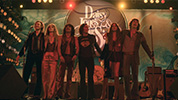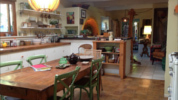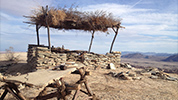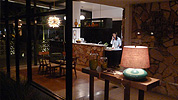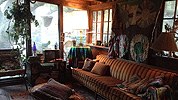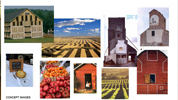Lisa Clark has worked in feature film, TV, streaming, documentary film, and museum exhibition for the past 18 years. Her projects have ranged from independent to large-scale productions where she regularly serves in the role of Set Decorator. She began her career in theater designing sets in San Francisco for over 25 productions including several West Coast premieres. She feels it is her theater experience that gave her a solid foundation for the design process used in film and TV.
Some of her recent Set Decorator credits include collaborations with Production Designer Jess Kender on the Emmy nominated Amazon series Daisy Jones and the Six, the ADG nominated Hulu series Little Fires Everywhere, and the ADG nominated Hulu series Future Man. Other notable projects include the feature The Last Days in the Desert with Production Designer Jeannine Oppewall and the feature Dog with Production Designer Laurence Bennett.
Lisa received a B.A. in History and Set Design from Stanford, and an M.A. in History from UC Berkeley. Her expertise in historical research has played a key role in her development as a designer, providing her with strong research skills and a keen attention to detail. She sees research as a key component of her work, believing an investigative curiosity leads to emotional believability in her sets. No matter the medium, Lisa brings a wide variety of skills to every project and is committed to a rewarding creative collaboration.
- Download: Resume (PDF)
- Jun.09.2023
- Interview with Lisa Clark and Jess Kender about Daisy Jones & The Six
- Daisy Jones & The Six on stage SET DECOR
- Mar.02.2023
- The production design is spot-on as we feel immersed in the early 1970s music scene in L.A.
- Daisy Jones & The Six on stage, Chicago Sun-Times
- Feb.18.2023
- The 1970s-era sets are designed to shag-carpeted verisimilitude.
- Daisy Jones & The Six on stage, The New York Times
- Aug.24.2023
- Emmy nomination announcement
- Daisy Jones & The Six on stage, Forbes
- Mar.07.2023
- …a nicotine stained homage…
- Daisy Jones & The Six on stage, The Daily Beast
- Dec.06.2022
- …a jaw-dropping makeover of the Sunset Strip.
- Daisy Jones & The Six on stage, Fanity Fair
- Mar.01.2023
- And the ’70s-era costumes and set design draw the audience into its world of sex, drugs, and, yes, rock ’n’ roll.
- Daisy Jones & The Six on stage, The A.V. Club
- Mar.02.2023
- The period vibe is meticulously rendered in the production design…
- Daisy Jones & The Six on stage, The Age
- Mar.03.2023
- The effort put into production design…balances glamour and nastiness which comes with living the high life.
- Daisy Jones & The Six on stage, AFTER MISERY
- Aug.10.2023
- …a gorgeously textured heightened reality that firmly exists in the very real iconic venues of Los Angeles.
- Daisy Jones & The Six on stage, IndieWire
- Jul.29.2023
- Interview with Jess Kender about Daisy Jones
- Daisy Jones & The Six on stage, Pushing Pixels
- Jul.29.2020
- Interview with Lisa Clark about Little Fires
- Little Fires Everywhere, SDSA Set Decorators
- Mar.13.2020
- The Richardson mansion plays an additional character that should receive top billing in the credits…
- Little Fires Everywhere, Architectural Digest
- Mar.13.2020
- Overscale furnishings straight out of Pottery Barn circa the 1990s were used for the den, while Roman shades and valences are also reminiscent of the period decor. To aid the plot points (no spoiler alerts here), Kender and Clark sourced accessories with an Asian influence such as Ming-vase-pattered fabric found at every fold of the curtain valence…
- Little Fires Everywhere, Architectural Digest
- Apr.08.2020
- The best part of Little Fires Everywhere is the ‘90s nostalgia.
- Little Fires Everywhere, The Cut
- Apr.08.2020
- The most appealingly nostalgic moments come whenever we get to see one of the five teen character’s bedrooms.
- Little Fires Everywhere, The Cut
- Apr.08.2020
- While there’s a lot to like about the show, my favorite part has been the scavenger-hunt appeal of locating things in the background that remind me of my tween years.
- Little Fires Everywhere, The Cut
- Mar.30.2020
- As much as the show is an intimate and dramatic look at motherhood, gender roles, racism, and privilege, it also doubles as a time capsule of the 1990s. The eight episode mini-series expertly transports millennial viewers, like myself, to our childhood…
- Little Fires Everywhere, Marie Claire
- Feb.14.2012
- The actors excel at clarifying the racial import (in interpreting sanity), with Lisa Clark's symbolic set of suspended green ward doors and David Molina's psychiatric-ward soundtrack adding credence to Robert's argument that commitment could drive people crazy.
- Blue/Orange, San Francisco Chronicle
- Apr.06.2011
- Lisa Clark's set – essentially a stand of barren trees – is perfect for a story that, while taking place mostly in a palace, never quite escapes the harsh forest landscape in which it begins.
- Beardo, SF Weekly
- Apr.05.2011
- Magnificently leafless tree trunks (courtesy of scenic designer Lisa Clark) rise ominously around the man, Beardo, while nestled among them lurks a somewhat inconspicuous string quintet.
- Beardo, SF Bay Gaurdian
- Mar.30.2011
- Beardo starts off with a tableau image of Russian peasantry. The title character lies comatose in a birch-tree forest – carefully designed by Lisa Clark.
- Beardo, East Bay Express
- Apr.26.2010
- The characters flounder through an ethereal landscape (designed by Lisa Clark) that could either be cumulus, or a field of snow (it serves in both capacities). No object is what it seems: Ted calls home through a cup that's attached to a telephone wire, which doubles as a clothesline.
- God's Ear, The East Bay Express
- Apr.26.2010
- Lisa Clark's set is breathtaking, full of lovely white clouds surrounding the stage with very few props.
- God's Ear, Talking Broadway
- Apr.24.2010
- The main character goes off on extensive travels, perhaps for business or maybe more as a metaphor for the estrangement afflicting his marriage - echoed in the ice-cascade landscape of Lisa Clark's set.
- God's Ear, San Francisco Chronicle
- Apr.07.2009
- "The talented creative team…fashion[s] a pithy theatrical experience through…such visual elements as the artful scenic juxtaposition of black-and-white newspaper flats and dirty, graffiti-scrawled facades."
- The Story, SF Weekly
- Mar.10.2009
- "…in a model apartment in which everything is a shining, useless surface …memories from the concentration camp…emerge amid the oppressive Miami pastels of Lisa Clark's pitch-perfect set. The result is a disorienting, inconclusive fever dream designed to mock the notion that time heals all wounds."
- The Model Apartment, SF Weekly
- Oct.03.2008
- "Set against Lisa Clark's claustrophobic backdrop of grey, narrow, precariously inward-leaning Victorian facades… [the production] evoke[s] a history of heroic outcasts…"
- Vera Wilde, Arts Journal
- Sep.25.2008
- "This cannibalistic fable is deliciously laid out on the Ashby Stage, backed by the angular, vertiginous London row houses–windows like vacant, staring eyes–stylized and etched in black and white by Lisa Clark…"
- Vera Wilde, Berkeley Daily Planet
- Sep.24.2008
- "…the monochrome towers of Lisa Clark's set are a knockout…"
- Vera Wilde, East Bay Express
- Oct.17.2007
- The first thing you notice right away: Lisa Clark's set is simply stunning, capturing a reedy, tree-shaded marsh and the bare essentials of two houses…"
- Bulrusher, East Bay Express
- Sep.25.2007
- "When we first see Bulrusher, she’s standing amid the towering redwoods of Lisa Clark's beautiful forest set."
- Bulrusher, The Oakland Tribune
- Sep.24.2007
- "the action keeps switching…smoothly between the brothel and cramped cabin on either side of the river cutting through Lisa Clark's fine, rustic set."
- Bulrusher, Robert Hurwitt, San Francisco Chronicle
- Sep.24.2007
- "the action keeps switching…smoothly between the brothel and cramped cabin on either side of the river cutting through Lisa Clark's fine, rustic set."
- Bulrusher, Robert Hurwitt, San Francisco Chronicle
- 05.24.2007
- "…Mamet’s incisive language [is]…all the more disturbing when juxtaposed against set designer Lisa Clark’s effectively prototypical 1950’s living room."
- Cryptogram, The Daily Californian
- 05.23.2007
- “Lisa Clark's set combines sleek modern decor with period details such as an impressively ugly plaid couch.”
- Cryptogram, East Bay Express
- 02.13.2007
- "Myth and history meet in the boarding house, an intriguing collage-style set (in the manner of artist Romare Bearden, one of whose works inspired the play) by Lisa Clark. "
- Joe Turner's Come and Gone, San Francisco Chronicle
- 10.31.2006
- …a mammoth cast of 30…embodies a wide range of characters on Shotgun Players'…stage…transformed for the occasion by Lisa Clark into the skeletal framework of a dilapidated Victorian fixer-upper.”
- Love Is a Dream House in Lorin, SF Weekly
- 10.04.2006
- “Gardley tells the story through a few key families and one symbolic house, a striking image of a typical Berkeley Victorian (complete with bay window seat), half built and tilted as if emerging from the primordial ooze (set by Lisa Clark).”
- Love Is a Dream House in Lorin, San Francisco Chronicle
- 10.03.2006
- "… spare, effective set design by Lisa Clark…"
- Love Is a Dream House in Lorin, Oakland Tribune
- 04.05.2006
- "these two [main characters] meet down in the Mississippi Delta in a shotgun shack -- a marvelous creation by set designer Lisa Clark…"
- I Just Stopped by to See the Man, SF Weekly
- 03.31.2006
- "Lisa Clark's terrific scenic design -- a ramshackle house, ragged trees -- is so evocative you can almost feel the breeze blowing in off the Mississippi."
- I Just Stopped by to See the Man, Oakland Tribune
- 03.31.2006
- "… a strikingly ramshackle set by Lisa Clark…"
- I Just Stopped by to See the Man, San Francisco Chronicle
- 04.21.2006
- “He lives in a dusty ruin of a home, with monolithic wardrobes and broken candlesticks and a tarnished suit of armor by the door. (Lisa Clark…designed the magnificent set.)”
- The Miser, SF Weekly
- 06.05.2002
- "… yupster Zoe (Robin Tunney) first lives in an actual loft, then moves abruptly to a prison space that has an eerie similarity to her previously tricked-out unit. In both locations the furniture has that plasticized scent of IKEA; it looks so drab it might as well have been state issued…"
- Cherish, San Francisco Bay Guardian
- 11.28.2002
- “Lisa Clark's scenic design and painting make clever use of…[the]space. A small cutout at the front of the apron provides a sort of basement…and the back of the stage has some unexpected features that transform the abstract gray painting/sculpture into a house that shifts in and out of focus in time with…[the] jarring sound effects and…evocative lighting.”
- Brave Brood, East Bay Express
- 11.20.2002
- "O'Hara keeps the action stark and sharply focused on an inventive urban-cavern set by Lisa Clark."
- Brave Brood, San Francisco Chronicle
- 08.2000
- "The first glimpse of the three-tiered set (excellent design by Lisa Clark)… rising from urban debris in the pit through a curtain of cyclone fences to a video screen-backed, raised platform, literally makes the scene."
- Julius Caesar, Theater Review
- 09.03.1999
- "… Lisa Clark's costumes were inventive, colorful, and perfectly aligned to character, situation, and… ease of movement."
- The Snow Queen, Off-Off Broadway Review
- 02.26.1999
- "… exuberant touches are provided by Lisa Clark's costumes (Macheath's Dick Tracy pinstripes, Lucy Brown's outlandishly large pink hat-bow…"
- Threepenny Opera, Palo Alto Weekly
